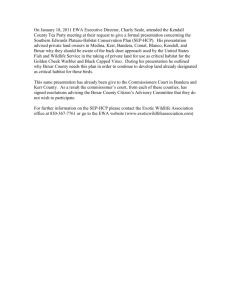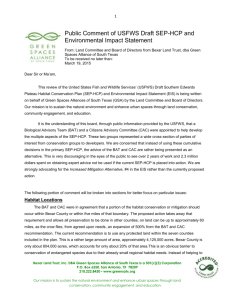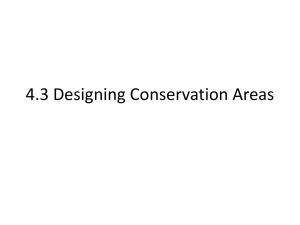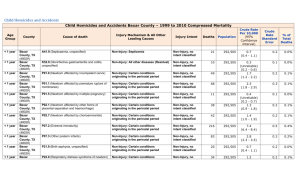Comment-on-SEP-HCP.3.. - Green Spaces Alliance
advertisement
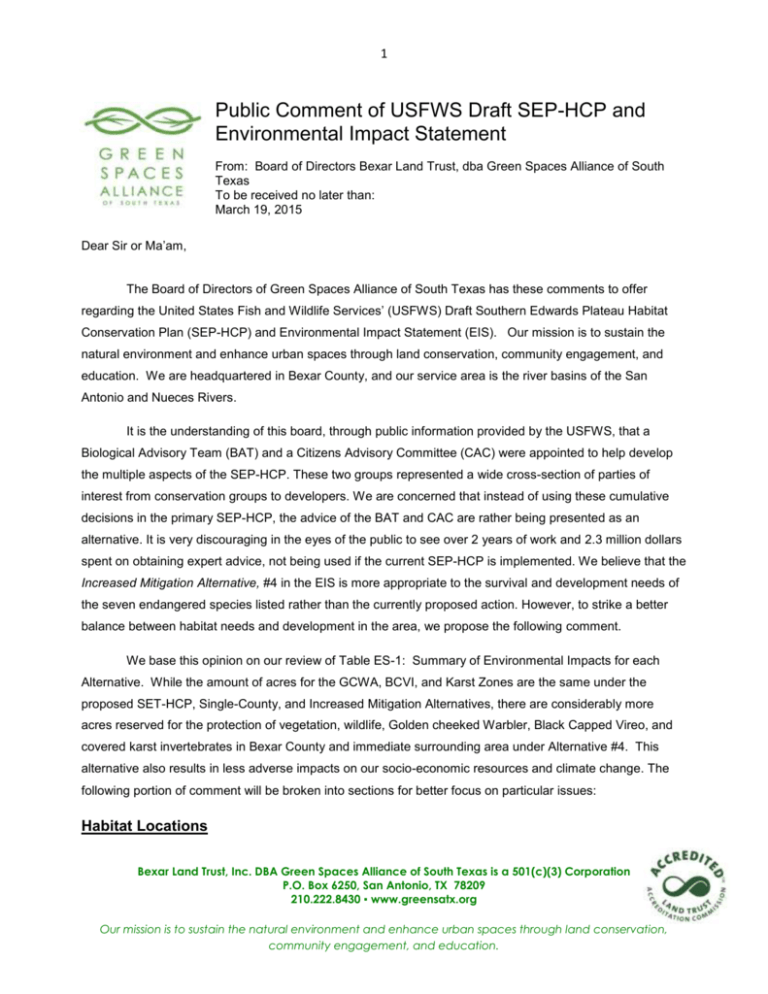
1 Public Comment of USFWS Draft SEP-HCP and Environmental Impact Statement From: Board of Directors Bexar Land Trust, dba Green Spaces Alliance of South Texas To be received no later than: March 19, 2015 Dear Sir or Ma’am, The Board of Directors of Green Spaces Alliance of South Texas has these comments to offer regarding the United States Fish and Wildlife Services’ (USFWS) Draft Southern Edwards Plateau Habitat Conservation Plan (SEP-HCP) and Environmental Impact Statement (EIS). Our mission is to sustain the natural environment and enhance urban spaces through land conservation, community engagement, and education. We are headquartered in Bexar County, and our service area is the river basins of the San Antonio and Nueces Rivers. It is the understanding of this board, through public information provided by the USFWS, that a Biological Advisory Team (BAT) and a Citizens Advisory Committee (CAC) were appointed to help develop the multiple aspects of the SEP-HCP. These two groups represented a wide cross-section of parties of interest from conservation groups to developers. We are concerned that instead of using these cumulative decisions in the primary SEP-HCP, the advice of the BAT and CAC are rather being presented as an alternative. It is very discouraging in the eyes of the public to see over 2 years of work and 2.3 million dollars spent on obtaining expert advice, not being used if the current SEP-HCP is implemented. We believe that the Increased Mitigation Alternative, #4 in the EIS is more appropriate to the survival and development needs of the seven endangered species listed rather than the currently proposed action. However, to strike a better balance between habitat needs and development in the area, we propose the following comment. We base this opinion on our review of Table ES-1: Summary of Environmental Impacts for each Alternative. While the amount of acres for the GCWA, BCVI, and Karst Zones are the same under the proposed SET-HCP, Single-County, and Increased Mitigation Alternatives, there are considerably more acres reserved for the protection of vegetation, wildlife, Golden cheeked Warbler, Black Capped Vireo, and covered karst invertebrates in Bexar County and immediate surrounding area under Alternative #4. This alternative also results in less adverse impacts on our socio-economic resources and climate change. The following portion of comment will be broken into sections for better focus on particular issues: Habitat Locations Bexar Land Trust, Inc. DBA Green Spaces Alliance of South Texas is a 501(c)(3) Corporation P.O. Box 6250, San Antonio, TX 78209 210.222.8430 ▪ www.greensatx.org Our mission is to sustain the natural environment and enhance urban spaces through land conservation, community engagement, and education. 2 The BAT and CAC were in agreement that a portion of the habitat conservation or mitigation should occur inside Bexar County or within five miles of that boundary. The proposed action removes that requirement and allows all preservation to be done in other counties, on land that can be up to approximately 60 miles, as the crow flies, from agreed upon needs. This is an expansion of 500% of the BAT and CAC recommendation. The current recommendation is to use any protected land within the seven counties included in the plan. This is a rather large amount of area, approximately 4,125,000 acres. Bexar County is only about 804,000 acres, accounting for only about 20% of that area.This is an obvious barrier to conservation of endangered species due to their already small regional habitat needs. Instead of helping to conserve these species habitats, the proposed plan will only concentrate their location to the fringes of their natural range. Also, this proposed plan replaces habitat that is under imminent threat of development with habitat that is under no threat of development for the next 30 years, and for a much cheaper price than the land they are taking actually costs. Bexar County has stated that they would like to have some of the mitigation land within or surrounding Bexar County. And, there is suitable undevelopable GCW and BCV habitat within the area. Yet the proposed alternative could result in no lands being mitigated within or surrounding Bexar County. While we appreciate the pressures to develop, we support some ratio of conservation within and surrounding Bexar County. Development can not only be detrimental to the endangered species in question, but it is a barrier to the education of the public and decreases their sense of responsibility for the environment. Instead there will be even more disconnect from inner city populations to those species that need protection from becoming extinct. We hope that the USFWS sees the importance of conserving habitat close the human population concentrations. We also believe many would agree that the success of other county-wide HCPs has much to do with the proximity of the habitat preserves to major population centres. With the loss of this proximity, there is a larger possibility of failure for this HCP. Resilience in the face of Climate Change requires a variety of ecosystems, a mosaic landscape sustaining as much biodiversity and habitat health as possible. Similarly, resilience needs redundant landscapes and ecosystems to provide protecting against ecosystem failure or loss. This plan moves in the opposite direction to what a responsible response to Climate Change necessitates. Not only should we preserve habitat in extended rural areas but we need to preserve as much as we can within Bexar County as well. Karsts Species It is our understanding that when a listed species is found at a site, its habitat is automatically protected. Why then, would we replace habitat potentially containing Karst species with habitat that already contains known occupied karst features? These features are already protected and do not need further protection. It makes much more sense to protect land that is not protected and could potentially be beneficial to those karst species. When wetlands are taken or linear feet of streams are impacted, they are replaced in Bexar Land Trust, Inc. DBA Green Spaces Alliance of South Texas is a 501(c)(3) Corporation P.O. Box 6250, San Antonio, TX 78209 210.222.8430 ▪ www.greensatx.org Our mission is to sustain the natural environment and enhance urban spaces through land conservation, community engagement, and education. 3 value due to the beneficial nature of a wetland or stream and its specialized habitat. We cannot replace or rebuild karst features as we can wetlands and streams in mitigation banks. Once destroyed, everything the karst features contain is lost forever, and the intricate nature of the underground connections is disrupted. The karst features zones are ranked on a scale from one to five in order of most likely to contain one of the endangered species to least likely to contain the endangered species, with the top three zones requiring a survey by a qualified biologist or geologist to discover karst features. Under the proposed SEP-HCP, once a parcel containing karst features is identified, that acreage is replaced essentially at ratio of 20-1, or for every 20 acres taken of potential habitat, one acre of known occupied karst features will be protected. Not only is this a contradiction in how a ITP usually works, because usually more acreage needs to be replaced than what is being taken, but it also is protecting something that is already protected by federal law. These karst permits are not necessary if we are only protecting what is already protected under the Endangered Species Act, and they should not be used as mitigation. This same plan would never be implemented for the Golden Cheek Warbler, i.e., to take 20 acres of potential habitat and replace with one acre of known habitat. This may be how the system works but what we understood that the habitat ratio had to at the least be 1:1. Biological Surveys Currently the USFWS requires a 3-year survey for the song birds in question (GCW and BCV) and a 15 day biological survey for karst species. The plan under comment actually reduces both of these time periods by 66% to 1 year for song birds and 5 days for karst species. This is incredibly unreasonable due to variations in seasons and local weather patterns, which have a great effect on occurrence of said species in biological surveys. If there is to be a reduction in the time requirements for species surveys, then there should be some justification for these reductions. We cannot find any such justification. Reducing the time for these surveys does place those endangered species at risk, and therefore, increases the risk of species take. This is not just our opinion. The recommendation from the BAT or CAC recommended continuing with current methods outlined by USFWS. Monitoring This section is included in our comments but details are not included in the SEP-HCP. As a land trust, we understand financial and time resources necessary to ensure proper stewardship of land. A management plan is fundamental to the maintenance of conserved lands, yet this SET-HCP is lacking one. Other HCPs have management plans. We wonder why this HCP has not made an attempt to propose both the administrative and financial steps necessary for perpetual monitoring. Costs and Funding Bexar Land Trust, Inc. DBA Green Spaces Alliance of South Texas is a 501(c)(3) Corporation P.O. Box 6250, San Antonio, TX 78209 210.222.8430 ▪ www.greensatx.org Our mission is to sustain the natural environment and enhance urban spaces through land conservation, community engagement, and education. 4 Page iv of the Draft Environmental Impact Statement estimates sources of revenue for the alternatives which we find unrealistic. Proposed SEP-HCP Alternative: 74% from participation fees, 26% from public sources 10% Participation Alternative: 47% from participation fees, 53% from public sources Single-County Alternative: 46% from participation fees, 54% from public sources Increased Mitigation Alternative: 37% from participation fees, 63% from public sources While a conservation easement may cost $4,000/acre in outlying counties, it is likely to cost much more in Bexar County; and the estimate does not include the due diligence costs associated with appraisals, biological surveys, maintenance and monitoring in perpetuity, and staff and other costs. In addition, there seems to be no allowance for the cost of fee simple purchase. Under all alternatives, the landowner participation fee cost per acre is too low. Further, we assume that increasing the costs of participation by the private landowners who will be benefitting from this process will reduce the amount given by public sources. One of the things we have not found in our review is a commitment for the public funding. Are we to assume there is a commitment? If so, what is the fundraising plan by Bexar County, as the entity that has signed the Federal Fish and Wildlife Permit Application Form? We also noted that none of the alternatives consider future increases in land values. Any serious recommendation for the next 30 years would take that into account. We are asking that an adequate model for future funding and monitoring be brought forward for approval along with the SEP-HCP. Conclusion There are still many logistical questions about how this HCP will be implemented such as property appraisals for mitigation, specific funding sources for property acquisition and plan implementation, and the specific roles of the city and county. We should also consider what the process might be when dealing with unforeseen circumstances. This leads to the question of what roles the city and county will play in reporting to USFWS as well as monitoring future mitigation sites. The county and city have already paid for two different committees dedicated to the construction of this SEP-HCP, and it is the opinion of our Board of Directors that their recommendations should be the heart of the SEP-HCP. If there is cause for diverting from their advice than let the justification become public. There is no expectation for the SEP-HCP to be a cheap remedy for urban sprawl. Instead the SEP-HCP should be a measure of the impact development is having on the environment around San Antonio. That measure is expensive, so let us allocate its costs appropriately and develop a suitable program of habitat conservation. The HCP will be in place for at least 30 years, with its effects having the potential to change the landscape of South Texas for centuries to come. We agree with the large team of experts, citizens, and the Bexar Land Trust, Inc. DBA Green Spaces Alliance of South Texas is a 501(c)(3) Corporation P.O. Box 6250, San Antonio, TX 78209 210.222.8430 ▪ www.greensatx.org Our mission is to sustain the natural environment and enhance urban spaces through land conservation, community engagement, and education. 5 development community in the form of the BAT and CAC, which are much more closely related to the Increased Mitigation Alternative #4 than the current proposal, so it is the Increased Mitigation Alternative #4 that we at GSA also recommend. We believe that the Increased Mitigation Alternative, #4 in the EIS is more appropriate to the survival of the seven endangered species listed rather than the currently proposed action. However, to strike a better balance between habitat needs and development in the area, we propose those changes listed throughout this comment. It is understood that development will continue, and a plan that helps conserve or replace vulnerable habitats is needed. It is our role as citizens of this city, county, and country to ensure the responsible development of that plan. Graph Summary of what we think should change from the proposed action: Subject Proposed Our Comment GCW Mitigation Ratio 2:1 Agree, 2:1 GCW Mitigation Location Anywhere in the 7 counties 50% mandatory in Bexar County Determining Presence/absence 1/3 USFWS Standards Keep USFWS Standards Cost Per Credit GCW/BCV $4,000 $10,000 Or 70% by developer/30% by the public Model for public cost funding Future tax on new development Agree Funds to begin the program Not stated $10,000,000 – by the County Bexar Land Trust, Inc. DBA Green Spaces Alliance of South Texas is a 501(c)(3) Corporation P.O. Box 6250, San Antonio, TX 78209 210.222.8430 ▪ www.greensatx.org Our mission is to sustain the natural environment and enhance urban spaces through land conservation, community engagement, and education.
